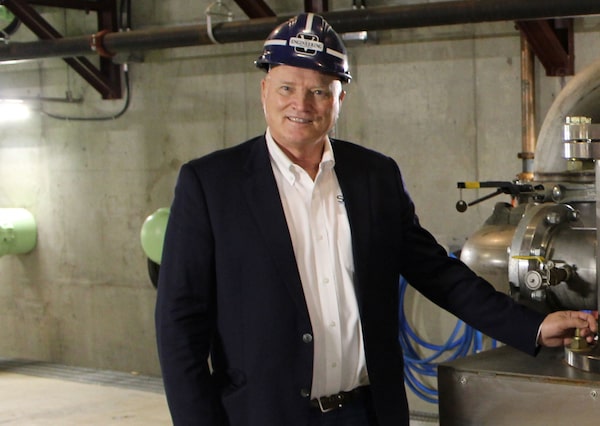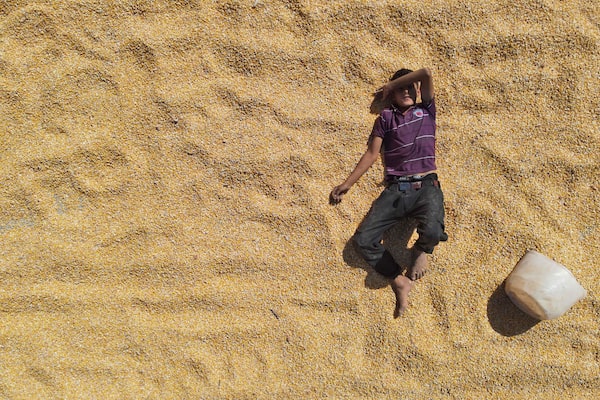If you’re reading this on the web or someone forwarded this e-mail newsletter to you, you can sign up for Globe Climate and all Globe newsletters here.
Good afternoon, and welcome to Globe Climate, a newsletter about climate change, environment and resources in Canada.
Methane’s heat-trapping effects were cause for alarm when gas began escaping from the Nord Stream 1 and 2 pipelines, which run from Russia to Western Europe. Methane is invisible to the human eye, but a Canadian satellite has captured the first direct view of methane leaking into the atmosphere from the ruptured pipelines under the Baltic Sea. The image suggests that as of Friday evening, the leak was still producing 22,920 kilograms of methane per hour – comparable to some of the largest manmade sources of methane anywhere on Earth. Today, Sweden sent a diving vessel to probe the leak.
Now, let’s catch you up on other news.

An image of the methane leak from Nordstream as seen by the GHGSat team in Montreal. They are able to calculate exactly how much methane is being released. This is the first direct measurement of the methane coming out of the damaged pipeline.GHGSat
Noteworthy reporting this week:
- Plants: On the balcony and in the backyard, prepare your container garden for winter. Or, read about the rare lichen enlisted in old-growth logging battle
- Water: With hard-won water rights, Indigenous tribes in U.S. consider how to manage rivers – and who profits
- Resources: Canadian-based International Battery Metals claims to have better way of extracting lithium. Meanwhile, “Ring of Fire Metals” moves forward in its attempt to build contentious EV nickel mine in Ontario’s Far North.
- Energy: Canada’s regulations are slowing renewables transition, Shell executives say. Also, Ottawa’s consultation on oil and gas emissions cap is under fire from Indigenous group
- Quebec election: Commuter tunnel a sign of Quebec’s complicated environmental record
- From The Narwhal: Can sweetgrass sequester carbon? Piikani Nation plans to find out
A deeper dive
What is storm surge?
Matthew McClearn is an investigative data journalist on the energy, environment and resource team. For this week’s deeper dive, he explains more about why storms are getting worse.
David Sansom, president of the Red Head Harbour Authority, was out checking how boats tied up along the harbour’s north wharf were faring amid the onslaught of post tropical storm Fiona. In half an hour, he estimated the sea level at his port on Prince Edward Island’s northern coast rose between five and seven feet. When it reached his bumper, he retreated. And not a moment too soon: The wharf “let go” 10 minutes later.
“The whole top plate of the wharf separated, with all the boats still tied to it,” Mr. Sansom said. “We’ve never had a storm of that magnitude.”
Storm surge is a combination of low atmospheric pressure (which can raise sea levels by as much as half a metre) and wind (which can raise them even higher). Waves ride on top of it. Fiona’s surge broke water level records at four tidal gauges across Atlantic Canada — and literally broke at least two gauges. It destroyed most of Red Head Harbour’s wharf infrastructure and two buildings. In Newfoundland, it’s estimated that nearly 100 homes were rendered uninhabitable, many shorn from their very foundations.
Lindsey Fudge carries groceries through the devastation left by hurricane Fiona in Burnt Island, Newfoundland on Wednesday September 28, 2022. Fudge and his mobility compromised parents weathered the storm on a remote point that was cut off by the storm surge.Frank Gunn/The Canadian Press
Jason Simpson, who owns an aquaculture operation called Simpson Aqua Ventures Ltd., learned a lot from 2019′s post-tropical storm Dorian about how to batten down the hatches. But that didn’t prepare him for Fiona’s aftermath in Savage Harbour, P.E.I., where his company operates. His boom truck and tractor were flooded. Storm surge washed away two of his five boats. His building, the highest at the port, had a foot and a half of water inside.
He and many others spent most of last week retrieving all that gear from along the shoreline. “We’ve hauled lobster traps, propane tanks, tires, patio furniture, screen doors … Lord knows where half this stuff came from.”
Storm surge is virtually certain to get worse. Where sea levels are rising, storm surge flooding will increase in frequency and magnitude. That will accelerate the erosion that’s already threatening P.E.I., which features lots of sands and sandstone.
Over the last century, sea levels around P.E.I. have already risen about 30 centimetres, said Adam Fenech, professor at the University of P.E.I.’s climate school. But over the next century, they could rise between one and two metres.
“So we really do have to be prepared,” he said. “At two metres, Prince Edward Island becomes three islands.”
More reading on Hurricane Fiona:
- In the wake of Fiona, Newfoundlanders fear the sea in communities that thrived on it for centuries
- Couple doesn’t let Hurricane Fiona spoil wedding, already postponed by pandemic
- Prime Minister Justin Trudeau pledges $10-million in relief, N.S. Premier blasts cellphone companies for poor service after Hurricane
- University students in Atlantic Canada navigating Fiona disaster
- Vignettes: Three stories of resilience as Atlantic Canada residents begin post-Fiona recovery
- Opinion: In Fiona’s wake, I first found silence, then a different kind of social cohesion
- Opinion: The important lessons we must learn from post-tropical storm Fiona
What else you missed
- Remediation of Giant Mine in NWT a cleanup on a vast scale
- Adapting to climate change faster will save Canada billions, new analysis says
- King Charles decides not to attend climate summit
Opinion and analysis
ROB magazine editor note: If we plan to meet our net-zero goals, natural gas isn’t a cure-all
Grant Bishop and Michael Bernstein: Alberta must address the looming risk of an unstable carbon market
David Johnston: The Aga Khan should inspire Canada to be a powerful catalyst for change
Patrick Brethour, Tax & Spend: The Conservatives are less wrong than the Liberals on the costs of carbon pricing
Green Investing
Canadian banks having second thoughts about Mark Carney’s green alliance over legal, governance risks
The banks’ qualms about the Glasgow Financial Alliance for Net Zero, or GFANZ, are coming to light as some of their U.S. counterparts consider leaving the organization over fears they could face legal action stemming from antitrust concerns if they are required to divest from some high-emitting sectors in the imperative to decarbonize.
Tensions flared this month in response to an update the Race to Zero initiative, which sets the criteria for emissions cuts, published in mid-June. Canadian banks have also recently discussed their concerns with U.S. counterparts, one source said. Sustainable investment reporter Jeffrey Jones and banking reporter James Bradshaw have the story.
- CPPIB says it’s using investments to push companies to decarbonize
- ESG losing momentum, but the problems it’s meant to tackle are growing, Thomson Reuters report finds
- Brookfield Renewable is buying two clean power companies for about $1.54-billion
Making waves
Each week The Globe will profile a Canadian making a difference. This week we’re highlighting the work of Lynn Mueller making energy out of wastewater.

Lynn Mueller, CEO of Vancouver-based SHARC EnergyHandout
Hello, I am Lynn Mueller, 67 years old and CEO of Vancouver-based SHARC Energy.
We have developed Wastewater Energy Technology (WET) to recover and reuse billions of dollars worth of renewable energy we are throwing away in the form of warm wastewater every day. The recovered clean energy is used for heating and cooling buildings and heating water tanks, significantly reducing the energy demand, energy costs and GHG emissions from the building sector, responsible for 17 per cent of Canada’s emissions.
In Canada alone, we can remove up to 54.7 million metric tonnes of CO2 annually, equivalent to taking 18.6 million cars off the street, just by utilizing the WET system in our buildings.
I have experienced climate change firsthand during my travels to the far north and if we want to save this planet for the next generation, we have to act now. I am committed to using the power of wastewater to help fight climate change and do what I can to make this world more livable for my family and others.
- Lynn
Do you know an engaged individual? Someone who represents the real engines pursuing change in the country? Email us at GlobeClimate@globeandmail.com to tell us about them.
Photo of the week

An aerial view shows a boy resting over drying corn near agricultural fields in the village of Jindayris in the Afrin region of Syria's rebel-held northern Aleppo province, on September 29, 2022. - The Middle East is heating at nearly twice the global average, threatening potentially devastating impacts on its people and economies, a new climate study shows. Barring swift policy changes, its more than 400 million people face extreme heatwaves, prolonged droughts and sea level rises, said the report released ahead of the UN's COP27 climate summit in Egypt later this year.RAMI AL SAYED/AFP/Getty Images
Catch up on Globe Climate
- Why getting women and girls in the fishing boat is good for the environment
- Is Canada’s largest farmland owner an optimist or pessimist?
- As temperatures rise, so does risk to athlete health
- Mercury in the Arctic puts Indigenous communities, wildlife at risk
We want to hear from you. Email us: GlobeClimate@globeandmail.com. Do you know someone who needs this newsletter? Send them to our Newsletters page.
 Sierra Bein
Sierra Bein